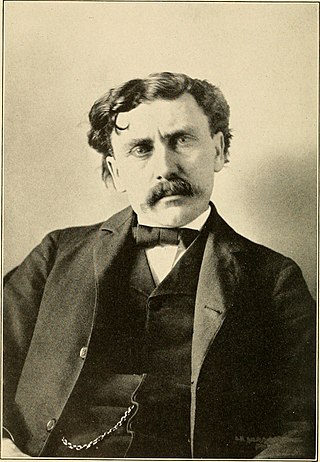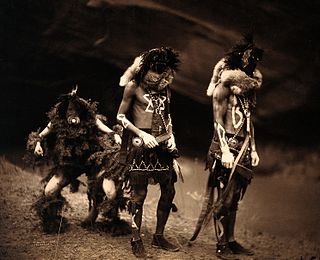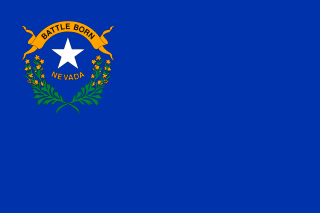Related Research Articles

In religion, a prophet or prophetess is an individual who is regarded as being in contact with a divine being and is said to speak on behalf of that being, serving as an intermediary with humanity by delivering messages or teachings from the supernatural source to other people. The message that the prophet conveys is called a prophecy.

James Mooney was an American ethnographer who lived for several years among the Cherokee. Known as "The Indian Man", he conducted major studies of Southeastern Indians, as well as of tribes on the Great Plains. He did ethnographic studies of the Ghost Dance, a spiritual movement among various Native American culture groups, after Sitting Bull's death in 1890. His works on the Cherokee include The Sacred Formulas of the Cherokees (1891), and Myths of the Cherokee (1900). All were published by the US Bureau of American Ethnology, within the Smithsonian Institution.

The Ghost Dance is a ceremony incorporated into numerous Native American belief systems. According to the teachings of the Northern Paiute spiritual leader Wovoka, proper practice of the dance would reunite the living with spirits of the dead, bring the spirits to fight on their behalf, end American Westward expansion, and bring peace, prosperity, and unity to Native American peoples throughout the region.

The Wounded Knee Massacre, also known as the Battle of Wounded Knee, was the deadliest mass shooting in American history, involving nearly three hundred Lakota people shot and killed by soldiers of the United States Army. The massacre, part of what the U.S. military called the Pine Ridge Campaign, occurred on December 29, 1890, near Wounded Knee Creek on the Lakota Pine Ridge Indian Reservation in South Dakota, following a botched attempt to disarm the Lakota camp. The previous day, a detachment of the U.S. 7th Cavalry Regiment commanded by Major Samuel M. Whitside approached Spotted Elk's band of Miniconjou Lakota and 38 Hunkpapa Lakota near Porcupine Butte and escorted them five miles westward to Wounded Knee Creek, where they made camp. The remainder of the 7th Cavalry Regiment, led by Colonel James W. Forsyth, arrived and surrounded the encampment. The regiment was supported by a battery of four Hotchkiss mountain guns. The Army was catering to the anxiety of settlers who called the conflict the Messiah War and were worried the Ghost Dance signified a potentially dangerous Sioux resurgence. Historian Jeffrey Ostler wrote in 2004, "Wounded Knee was not made up of a series of discrete unconnected events. Instead, from the disarming to the burial of the dead, it consisted of a series of acts held together by an underlying logic of racist domination."

Wovoka, also known as Jack Wilson, was the Paiute religious leader who founded a second episode of the Ghost Dance movement. Wovoka means "cutter" or "wood cutter" in the Northern Paiute language.

The Indigenous peoples of the Great Basin are Native Americans of the northern Great Basin, Snake River Plain, and upper Colorado River basin. The "Great Basin" is a cultural classification of indigenous peoples of the Americas and a cultural region located between the Rocky Mountains and the Sierra Nevada, in what is now Nevada, and parts of Oregon, California, Idaho, Wyoming, and Utah. The Great Basin region at the time of European contact was ~400,000 sq mi (1,000,000 km2). There is very little precipitation in the Great Basin area which affects the lifestyles and cultures of the inhabitants.

The Sioux Wars were a series of conflicts between the United States and various subgroups of the Sioux people which occurred in the later half of the 19th century. The earliest conflict came in 1854 when a fight broke out at Fort Laramie in Wyoming, when Sioux warriors killed 31 American soldiers in the Grattan Massacre, and the final came in 1890 during the Ghost Dance War.
Bois Caïman was the site of the first major meeting of enslaved blacks during which the first major slave insurrection of the Haitian Revolution was planned.
Black Reconstruction in America: An Essay Toward a History of the Part Which Black Folk Played in the Attempt to Reconstruct Democracy in America, 1860–1880 is a history of the Reconstruction era by W. E. B. Du Bois, first published in 1935. The book challenged the standard academic view of Reconstruction at the time, the Dunning School, which contended that the period was a failure and downplayed the contributions of African Americans. Du Bois instead emphasized the agency of Black people and freed slaves during the Civil War and Reconstruction and framed the period as one that held promise for a worker-ruled democracy to replace a slavery-based plantation economy.

Kicking Bear was an Oglala Lakota who became a band chief of the Miniconjou Lakota Sioux. He fought in several battles with his brother, Flying Hawk, and first cousin, Crazy Horse, during the War for the Black Hills, including the Battle of the Greasy Grass.

Tasunka Kokipapi, was an Oglala Lakota leader known for his participation in Red Cloud's War, as a negotiator for the Sioux Nation after the Wounded Knee Massacre, and for serving on delegations to Washington, D.C.. During and after his lifetime American sources and written records mistranslated his name as Young Man Afraid of His Horses or uncommonly as His-Horses-Are-Afraid, but a proper translation is They-Fear-Even-His-Horses or His Horse Is Feared, meaning that the bearer of the name was so feared in battle that even the sight of his horse would inspire fear.

Ghost shirts are shirts, or other clothing items, worn by members of the Ghost Dance religion, and thought to be imbued with spiritual powers. The religion was founded by Wovoka, a Northern Paiute Native American, in the late 19th century and quickly spread throughout the Indigenous peoples of the Great Basin and Plains tribes.

Cora Alice Du Bois was an American cultural anthropologist and a key figure in culture and personality studies and in psychological anthropology more generally. She was Samuel Zemurray Jr. and Doris Zemurray Stone-Radcliffe Professor at Radcliffe College from 1954. After retirement from Radcliffe, she was Professor-at-large at Cornell University (1971–1976) and for one term at the University of California, San Diego (1976).

Arnold Short Bull, a member of the Sičháŋǧu (Brulé) Lakota tribe of Native Americans, instrumental in bringing the Ghost Dance movement to the Rosebud Reservation.

Native American religions are the spiritual practices of the Native Americans in the United States. Ceremonial ways can vary widely and are based on the differing histories and beliefs of individual nations, tribes and bands. Early European explorers describe individual Native American tribes and even small bands as each having their own religious practices. Theology may be monotheistic, polytheistic, henotheistic, animistic, shamanistic, pantheistic or any combination thereof, among others. Traditional beliefs are usually passed down in the forms of oral histories, stories, allegories, and principles.
Coquelle Thompson was a Coquille Indian from the U.S. state of Oregon who was a cultural and linguistic consultant to at least six important anthropologists over the course of his long life. Born the son of a chief of the Upper Coquille Indians, and his Hanis Coos wife, he was among the several hundred Indians from southwestern Oregon who were removed by ship from Port Orford to the Coast or Siletz Indian Reservation in June 1856. His is an Indian eye-witness account of that removal. He grew up and lived on the Siletz Reservation, serving for decades as a member of the tribal police force.

The following outline is provided as an overview of and topical guide to the U.S. state of Nevada:

Porcupine was a Cheyenne chief and medicine man. He is best known for bringing the Ghost Dance religion to the Cheyenne. Raised with the Sioux of a Cheyenne mother, he married a Cheyenne himself and became a warrior in the Cheyenne Dog Soldiers.

Numerous new religious movements have formed in the United States. A new religious movement (NRM) is a religious or spiritual group that has modern origins and is peripheral to its society's dominant religious culture. There is no single, agreed-upon criterion for defining a "new religious movement".
Emma Cornelia Sickels (1854–1920) was an American teacher. She had a complex relationship with Indigenous peoples through her work with the US government. White society called her a hero for collecting information and mediating peace between the US and the Lakota people in 1890. During this time, she incorrectly blamed Native Americans for the Wounded Knee Massacre. In 1893, she was publicly fired from the Anthropology and Ethnology Department at the Chicago World's Fair for protesting how her boss was falsely showcasing Native American life to display Indigenous people as uncivilized.
References
- ↑ Mooney, James The Ghost Dance Religion and Wounded Knee. 1896. Reprint (London; Constable and Company, Ltd, 1973) 702
- ↑ Mooney, James 1896, 702
- ↑ Mooney, James 1896, 702
- ↑ Du Bois, Cora "The 1870 Ghost Dance" Anthropological Records Vol. 3, No. 1 (1939) (Berkeley, California: University of California Press) 3-5
- ↑ Mooney, James 1896, 703
- ↑ Du Bois, Cora 1939, 4-6
- ↑ Du Bois, Cora 1939, 3
- ↑ Hittman, Hittman Wovoka And The Ghost Dance: Expanded Edition (Lincoln, Nebraska: University of Nebraska Press 1997) 33